Youtube Acrysof Iq Restor Multifocal Toric Iol Reviews
Cataract surgery is one of the most mutual procedures across the globe and the number one surgery (of whatever stripe) performed in the United States. Simply with an expanding pool of potential postoperative outcomes, patients take a college demand than e'er for precision. Today's intraocular lens (IOL) technology, while imperfect, benefits from an array of recent innovations. While none replicate the center'south natural ability to accommodate and refocus at varying distances as in a pre-presbyopic middle, the newest slate of IOLs tin requite patients more independence from glasses than ever before.
The optometrist's part in preparing patients for cataract surgery includes a robust understanding of these bachelor IOL options and how to best match a patient to the technology that fits their priorities. As adept as the newest lenses may be, they still impose trade-offs among about, intermediate and distance vision. All patients are probable to experience improved vision subsequently the procedure, and many can achieve first-class postoperative acuity at multiple focal lengths—if nosotros do our jobs well in patient selection and pre-op pedagogy. This article volition give an overview of the procedure.
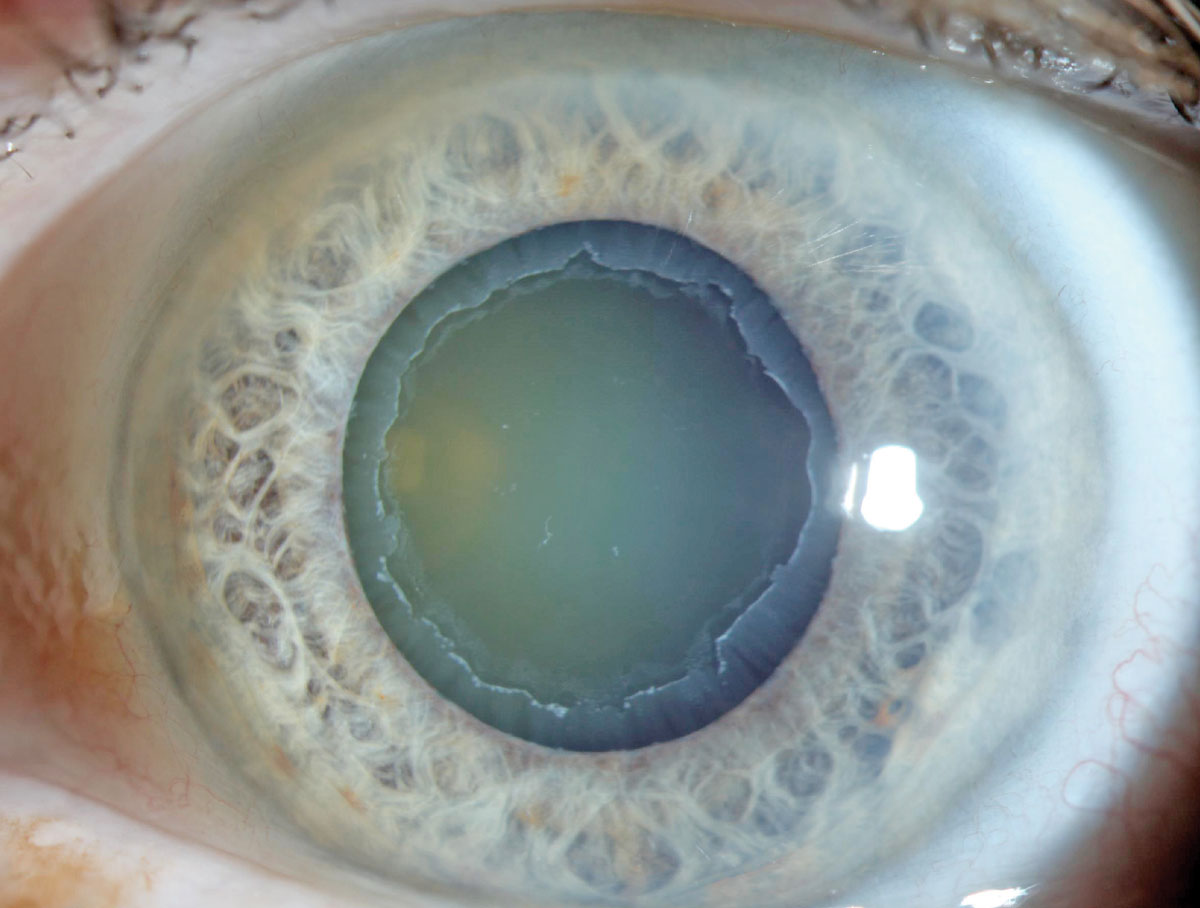 |
| Pseudoexfoliation can cause difficulty in IOL placement. Due to association with weak zonules, specialty lenses are contraindicated in these patients.Photo: Aaron Bronner, OD. Click image to enlarge. |
Showtime Things First
Initial consultation for cataract surgery should include best-corrected vigil, glare testing and a history that details the patient's lifestyle. To get an agreement of their expectations, commencement by discussing how reduced vigil affects their twenty-four hour period-to-24-hour interval performance. No "accented" acuity will qualify a patient for insurance reimbursement, simply a good rule of thumb is to brainstorm discussing the futurity demand for cataract surgery when the patient is beginning to struggle with those daily activities with no improvement despite glasses or contact lenses.
Recent research shows that when patients recognize postoperative visual improvements, they are more satisfied with the surgery—especially when they regain unaided about vision for reading after the cataract is removed.1 Younger patients, who however have some remaining accommodative ability left before the surgery, tend to rank their satisfaction lower postoperatively compared with those in their 70s or older.1,ii
If the patient does not nowadays with any glare issues from the cataract, the potential for "trading symptoms" is besides a concern.ii Equally initial dysphotopsia following surgery is non uncommon, patients also must be educated preoperatively about the potential for glare, arcs, streaks and halos initially later on surgery.
In add-on, proper reassurance during the healing menstruum that neuroadaptation improves with fourth dimension will assist minimize patient stress during the recovery process.
Toric IOLs
Of the two broad categories of premium IOLs—toric and presbyopic—the old is more probable to succeed. However, while 52% of patients can be treated with a toric IOL, only 7% of patients receive i.3 Of course, the starting time step is figuring out which patients are in that 52% who qualify.3
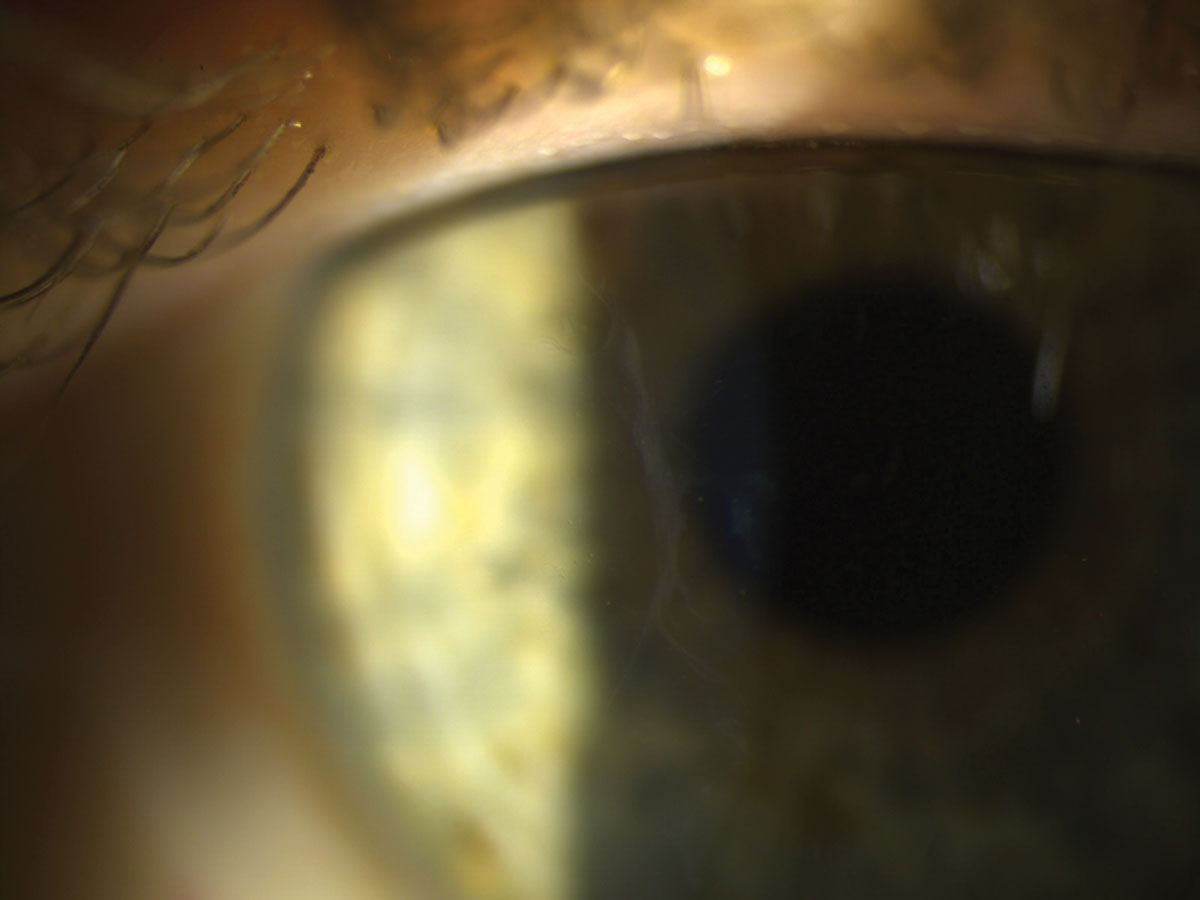 |
| Even subtle EBMD may disrupt aberrometry measurements and ultimately patient's visual outcome with a toric or premium IOL. Click image to enlarge. |
Whether incompatibility is due to personality quirks that brand accommodation difficult or preexisting ocular conditions that limit all-time-corrected visual acuity (BCVA), setting reasonable vision goals is the first step.4-6
Recent inquiry shows 'Blazon A' patients are more likely to fare poorly with a premium lens.4 A patient who has a long history of maladaptation to progressive lenses and updated prescriptions yearly may not be able to appreciate the gain of less dependence on glasses. Instead, these patients will more than likely nitpick at the small aberrations and dysphotopsias associated with these lenses. Conversely, those with more than amusing or open up personalities (Type B) tend to adapt ameliorate to the new lenses, whether standard or premium.4
Obvious ocular morbidities (due east.thousand., macular degeneration, ocular surface disease, diabetic retinopathy, glaucoma) are contraindicated and easily explained to patients.v More than subtle findings tend to crave more than caption as to why a premium lens would not be a proper friction match. These can include forme fruste keratoconus, mild epiretinal membrane and epithelial basement membrane dystrophy (EBMD), for which the patient has no symptoms.
One study earlier this twelvemonth found that EBMD can result in inaccurate biometric keratometry measurements used for IOL choice, leading to post-op refractive inaccuracies and patient dissatisfaction.4,vii Instead, the patient should exist educated on the diagnosis and potentially offered phototherapeutic keratectomy to polish out the corneal surface. However, if corneal opacity persists, many of these patients will be poor premium lens candidates.
Before cataract surgery, be sure to evaluate all patients with corneal topography. Instead of educating your patient on toric IOL candidacy based on refractive cylinder, using corneal topography offers more accurate information when calculating IOLs. You can compare your corneal topography findings to your autorefractor Ks to meet if the patient would likely exist a candidate for an astigmatism-correcting lens at the time of surgery. If the two measurements are non within half a diopter, the typical IOL increment, careful evaluation of the cornea may be warranted. As mentioned in a higher place, subtle changes like EBMD or dry centre can distort keratometric readings and, ultimately, post-op results.vii Management of such treatable corneal findings should be addressed before proceeding with cataract surgery measurements.
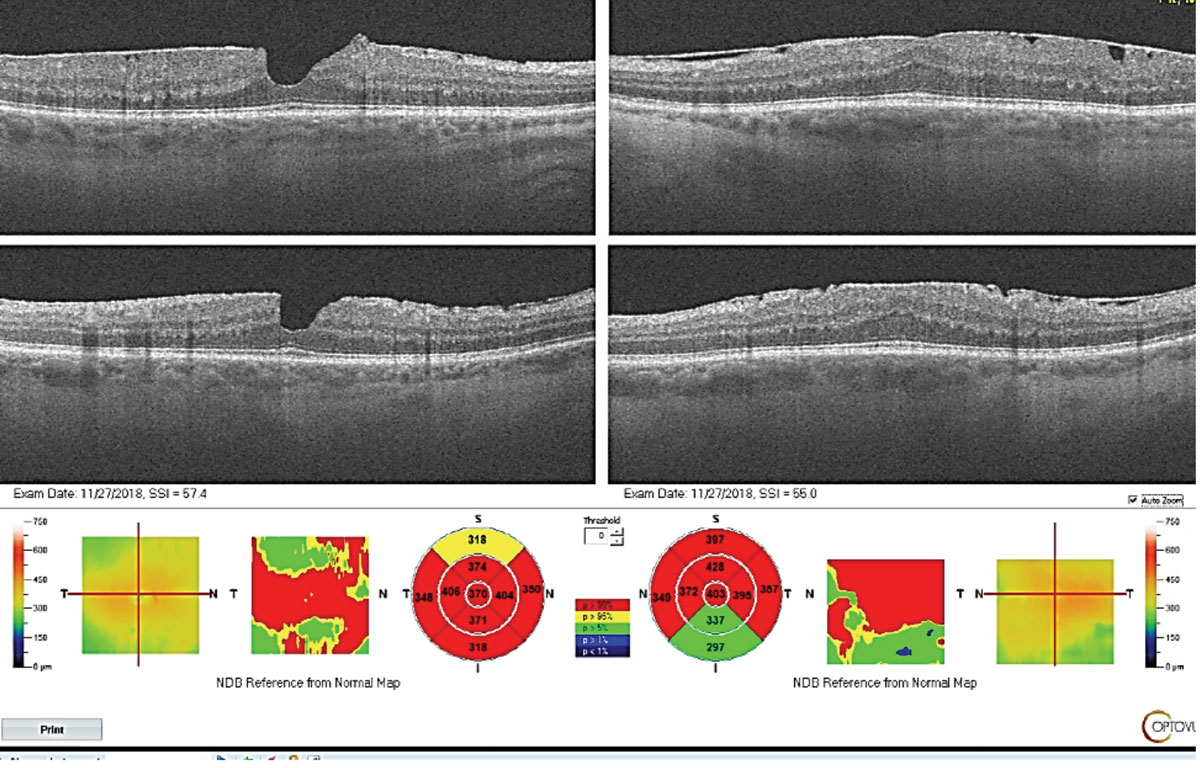 |
| Epiretinal membrane is a contraindication for proceeding with premium IOLs as the patient's vigil post-operatively is likely express. In improver, patients are at elevated risk for post-operative cystoid macular edema. Click prototype to enlarge. |
Furthermore, it is prudent to notify patients if they are at college run a risk for zonular dehiscence at the fourth dimension of surgery due to history of trauma, history of retinal detachment repair with silicone oil or presence of pseudoexfoliation. With weakened zonular integrity, orienting the centrality accurately or centering the lens in a poorly secured handbag will be hard. Luckily, a capsular tension ring is typically placed into the capsular handbag to help stabilize the structures enough to arrange a toric IOL.8
After evaluating for these contraindications and establishing demand for astigmatism correction, it'due south time to guide the toric-candidate through their options. Depending on the patient'southward preferred endpoint or chosen residual prescription, the benefits of electing a toric IOL may vary. If sharp distance vision without correction is their priority, then proceeding with a toric IOL is important in achieving their lifestyle goals. But careful discussion is needed to emphasize loss of intermediate and almost function in the unmarried-focus lens. In add-on, individuals with career environments that may raise sensitivity to glare, arcs, and other aberrations may benefit to neutralize their astigmatism to minimize ghosting and streaks with focal lights.6
What may as well be a crucial factor in a patient'southward determination making is the financial burden of opting for a non–insurance-covered lens. Conscientious consideration of the price/benefit tradeoffs of toric IOLs in patients hoping to retain nigh function volition depend on the patient'southward blur tolerance. Astigmatism below 1.50D may not negatively touch on their nearly acuity and a spectacle Rx at distance will be required to accomplish the best results anyway. If proceeding with a specialty lens comes at too high of a fiscal burden for the patient, the preoperative evaluation serves as an opportunity to create an alternative programme to achieve their goals once they are stable from cataract surgery.6 After evaluating for these contraindications, it's time to guide the toric candidate through their options.
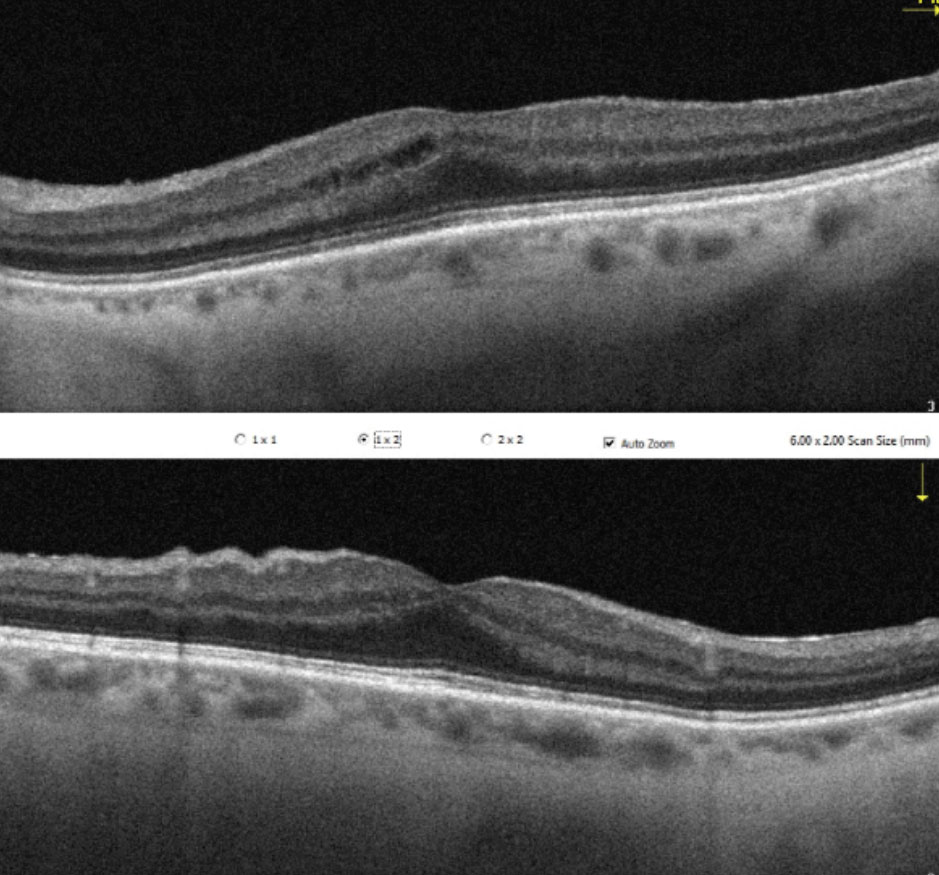 |
| Irvine-Gass syndrome 1.five months post-obit cataract surgery. Prompt treatment with an NSAID and steroid typically results in a skilful prognosis and full resolution in a few weeks. Click image to overstate. |
Femtosecond laser limbal relaxing incisions (LRI) may exist recommended to improve manage minor (<1.25D) amounts of corneal astigmatism. Though more than accurate than its manual predecessor, performing the LRI with a laser at an incorrect axis tin still occur and cannot be undone, resulting in increased or irregular astigmatism. Additional risks of LRIs include regression and wound leak, which makes toric IOLs the safer alternative even given the take a chance 10 degrees or more of rotation in a small-scale number of cases (less than three%).9,10
An enhancement procedure like LASIK or PRK mail service-cataract extraction can also accurately treat remainder refractive fault when needed.11 In cases where the patient presents with more than than 5D of corneal toricity and no other irregular corneal findings, a toric IOL to eliminate the majority of the prescription is done first, followed by a laser enhancement to fine-melody vision with much less tissue removal. Similar considerations demand to be fabricated when treating more than 2.5D of astigmatism matched with toric multifocal or extended-depth-of-focus lenses.
It's not merely a matter of opinion that optometry should be start to innovate patients to this data—enquiry backs the idea. If the patient is feeling well cared for and well-informed beginning with their primary eye care provider, overall satisfaction tends to score college, according to a Journal of Cataract and Refractive Surgery study.5,12 Anecdotally, we have institute that the better ODs prepare a patient, the smoother the process, and the meliorate it reflects on the optometrist. Repetition of information over fourth dimension allows the patient to slowly absorb and process the data that will heavily impact their quality of life in the future.
What'southward to Come up?
Newer IOL engineering in the pipeline looks to milkshake up the status quo yet once more. Below are just a few of the hopeful distruptors.
1. Lite-Adjustable Lens (RxSight). This was FDA approved this yr, but is not yet on the market. It'south the first lens that allows postoperative adjustments to address uncorrected visual acuity or even undecided visual endpoints. The lens is made of a photoreactive silicone that allows optical changes to exist induced postoperatively.21
2. Eyhance monofocal IOL (Johnson & Johnson Vision). This lens aims to target the monofocal market with a mild extension toward intermediate vision using an aspheric lens pattern and broader defocus bend rather than a diffractive design. The purported benefit is improved "sugariness spots" postoperatively compared to current monofocal IOLs. This lens may be optimal for those who do not mind wearing readers for near function and some intermediate tasks, but practice not want to deal with adapting to diffractive halos and decreased contrast sensitivity. While non yet FDA approved, information technology has been released into the European marketplace since Feb 2019.22
iii. IC-8 Modest Aperture Lens (AcuFocus). This lens uses the same technology as the Kamra corneal inlay to extend the depth of focus via pinhole result. The lens is currently proceeding with clinical trials in the U.S. estimated to be completed in May of 2020. European studies have shown upward to 2.25D range of focus.23,24
IOLs for Presbyopia
There are several categories of presbyopia-correcting IOLs on the market place:
Diffractive multifocals. These lenses employ several optical zones with different powers to establish split focal points. While multifocals will offering amend distance and most function (+two.50D range), some patients complain of a lack in clarity for intermediate activities. These include the Tecnis Multifocal (Johnson & Johnson Vision) and Acrysof IQ Restor (Alcon).
Extended-depth-of-focus IOLs. The Tecnis Symfony IOL (Johnson & Johnson Vision) lays claim to this category as an improvement upon conventional multifocal IOL performance. The lens uses chromatic aberration to create smoother transitions between its optical zones and fewer "dead zones" where vision is not-functional between ready focal points. Surgeons approximate information technology provides around +i.50D of range, requiring the patient to wear readers for detailed near activities like threading a needle or beading.
Accommodating or pseudo-accommodating IOLs. In this approach, used in the Crystalens AO and Trulign Toric from Bausch + Lomb, a flexible lens bows forrard, increasing the focusing power enough to improve near function of about +1.00D or more.
Trifocal IOLs. Though pop overseas for several years, this option has only recently come up to our shores when Alcon launched its PanOptix IOL a few months ago. The design is said to deliver improved quality of distance, intermediate and near function compared to previous generations of multifocal IOLs.13 PanOptix has three target focal points at optical infinity, 60cm and 40cm. It comes in both spherical and toric platforms, equally do the Restor 2.5 and Restor 3.0. However, PanOptix has unique engineering to use more than of the incoming calorie-free.
Monovision. As with contact lenses, monofocal IOLs can be called to establish one centre for distance and ane eye for about or intermediate. If the patient's not-dominant heart has practiced tolerance for mistiness, combining a dominant single-focus IOL with a non-dominant diffractive lens may allow the patient further freedom from spectacle wear.
Mix-and-match. Taking it a step farther, personalizing vision with a multifocal lens in i centre for improve near function paired with an EDOF or trifocal lens in the other may permit full range of vision past supplementing the intermediate zone. The possibilities are countless, merely conscientious cess of clinical findings is of import in ruling out those with contraindicated findings.14
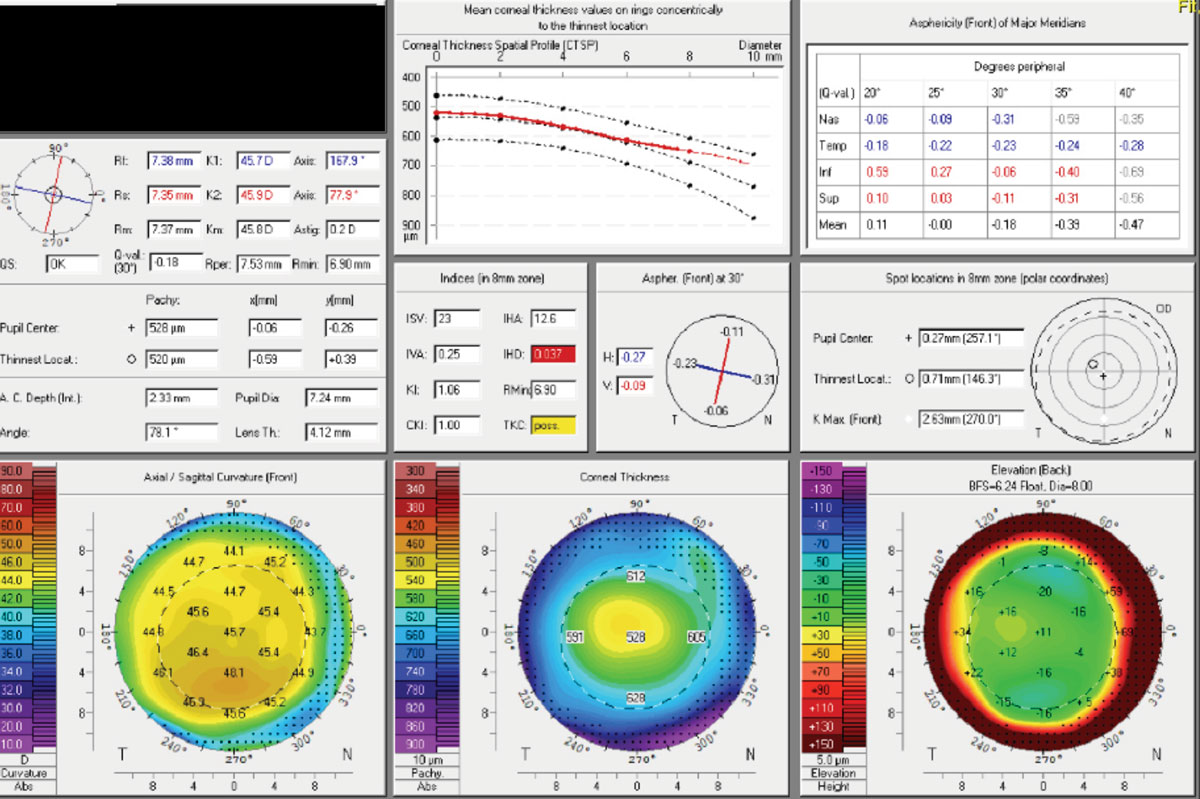 |
| Forme fruste keratoconus tin be subtle and is ofttimes missed in routine heart exams. Tools such as the Pentacam help identify those with irregular astigmatism as these patients are contraindicated for toric and presbyopia-fixing IOLs. Click image to enlarge. |
The goal is to minimize patients' need for corrective lenses co-ordinate to their distinct lifestyle requirements. Unfortunately, in that location is no lens that can completely guarantee absolute freedom from glasses 100% of the time. As the master care provider, it is important to emphasize a personalized strategy that all-time matches the patient'southward goals while establishing limitations. Reasons for Dissatisfaction
Even if you lot've done your chore correct prior to cataract surgery—evaluated patients thoroughly for ocular surface illness, explained the benefits and shortcomings of their called lens option and prepared them for a neural adaptation menses—the patient may all the same experience dissatisfaction with a premium IOL. Luckily, many of the following postoperative complications are treatable.
Most easily detected is residual refractive error. Once stability of the cornea is established with topography and manifest refraction, the patient can enhance their acuity with LASIK or PRK, which is much more customizable and predictable compared to cataract surgery. Enhancement procedures are often reviewed with patients who have a history of more than two years.
Secondly, and about easily treated, is posterior capsular opacification, which can occur in upwardly to 40% of patient following cataract surgery.xv Hazing of the posterior sheathing is typically more common in younger patients, equally well every bit those with diabetes, history of uveitis, and traumatic cataracts.16-19 The typical complaint consists of deadening return of glare and blur in vision afterward a period of clarity following cataract surgery.
Preparing the patient ahead of time nearly the risks and potential treatments alleviates the misunderstanding that the original cataract surgery "didn't work." Instead, the YAG capsulotomy becomes an predictable stride in clearer vision. Time of treatment may vary based on surgical clinics, merely the general rule is that it'south safe to continue once there is enough peripheral capsule scarring and fibrosis to secure the intraocular lens, which may take up to three months.
A more frustrating post-op complication is cystoid macular edema, too known as Irvine-Gass syndrome. Preventative care with a non-steroidal anti-inflammatory drug, in improver to the typical steroid and antibiotic combination, is used to minimize inflammatory reaction by disrupting the prostaglandin cascade. Fortunately, vision loss is ordinarily temporary and responds quickly to restarting topical anti-inflammatory therapy. More than severe or stubborn cases may require intravitreal injections with retina specialist. The nearly important thing as a principal eye care provider is to catch the presentation early as visual prognosis is better the sooner treatment is initiated.xx
Lastly, even if there are no mail-op complications, the patient may however be upset. The affluence of information that the patient considers at the cataract evaluation may lead to key concepts being forgotten—for example, the loss of near part in monofocal IOL utilise. In addition, they may hear "miracle" stories from friends and family members that are not realistic for their own instance. Therefore, repetition of information over several visits with their primary eye care provider is important in assuasive the patient to absorb the important fundamental points fully earlier surgery.
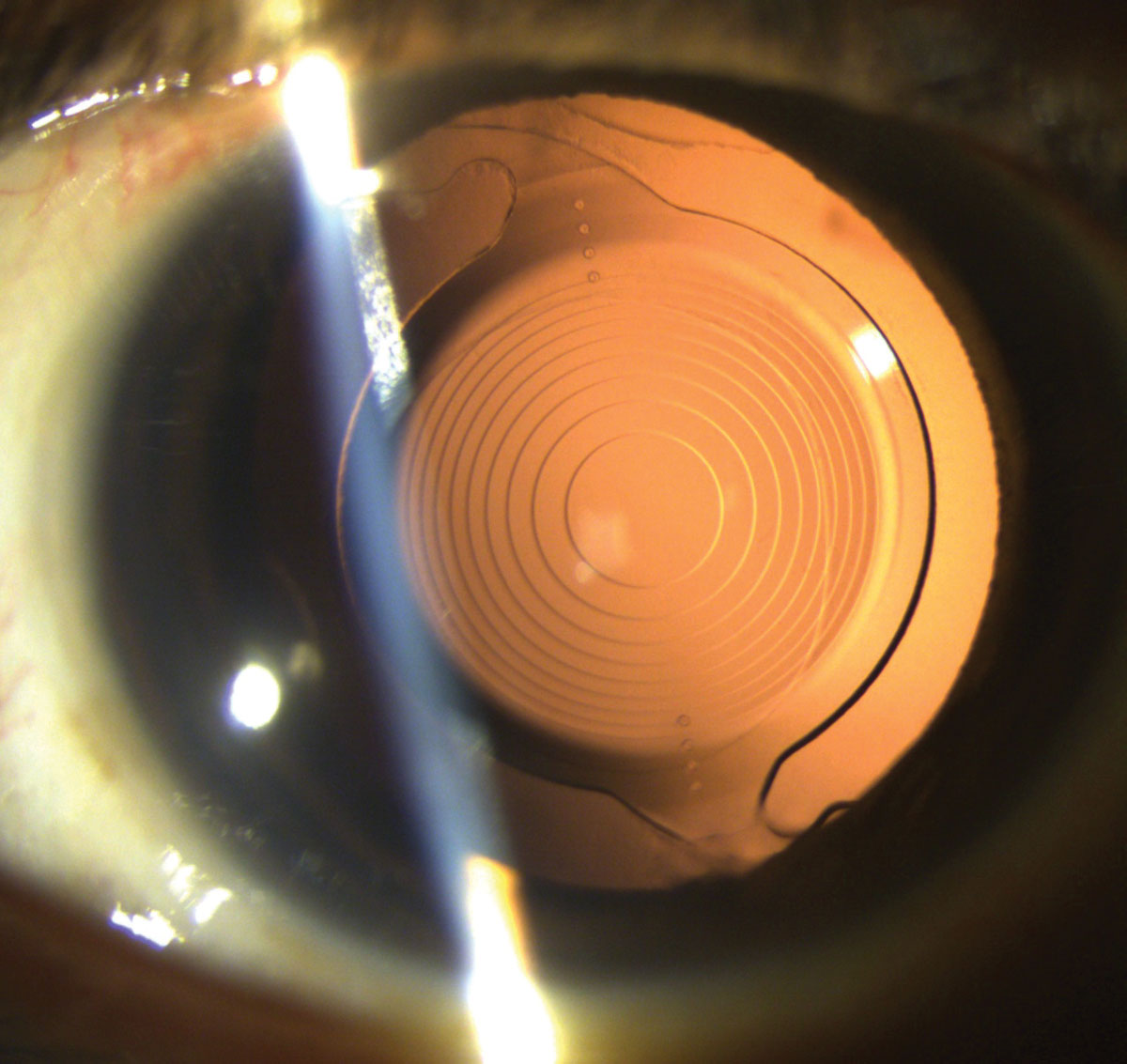 |
| This patient'south Toric Symfony IOL was implanted 1 day earlier this photo was taken. Click paradigm to enlarge. |
Information technology Starts With The states
Unfortunately, no thing how much we endeavour, there is no mode of determining which patients will absolutely adjust well to a premium lens. Virtually information is gained through the process of discussing patients' expectations and visual goals. Proceed in listen that, although someone is clinically a skillful candidate for a premium lens on paper, their lifestyle and personality may exclude them. The more you can empathise their hobbies, occupational requirements, and are able to make up one's mind which visual functions are most important to alter, the more likely they volition exist matched with the proper IOL.
Though patients are becoming more accepted to doing their own enquiry, they may just be reading the manufacturer information, which tends to leave out the potential negatives of their product. Information technology is essential that the middle care provider educate the patient well-nigh the compromise and gains of the options. If they are unable to surrender precipitous near function without demand for glasses, then they may ultimately be a improve candidate for monofocal IOLs with almost endpoints or monovision if they take a history of success using soft contact lenses. The boosted chair time that it takes in the initial discussion volition save you and the patient a lot of time and frustration in trying to fix or adapt to an "unexpected" visual outcome.
Individuals with higher distance visual demands (e.g., sharp shooters, photographers, long haul truck drivers, historical emmetropes) tend to struggle with the lower dissimilarity sensitivity and haloing effects of the presbyopia-correcting IOLs. Instead, they tend to prefer the sharpness of monofocal lenses, certainly opting for astigmatism correction to neutralize astigmatic aberrations. In particular, those who spend a lot of time in scotopic settings; for case, truck drivers often have to drive long distances at nighttime. Postoperative halos and starbursts from multifocal and extended depth of focus lenses may make information technology very difficult for them to perform their chore safely.
On the other finish of the spectrum, it is easy to fall into the trap of prioritizing distance vision for all patients. Myopic patients who enjoy near tasks such as crafting, reading, reckoner utilise or hairstyling may adopt to remain with an intermediate (-1.25D) or well-nigh (-2.50D) endpoint. This is a great opportunity to trial different options using soft contact lenses to simulate the loss of these working distances if they opt for distance vision.
Every bit the primary eye care provider, consider kickoff the process of determining lens selection early, when cataracts are first detected merely before the patient is symptomatic. Build rapport and patient loyalty by addressing their long-term needs early on on. Begin the conversation on what their platonic vision would be within the limitations of the current engineering. Start trialing unlike modes of vision from monovision to multifocal to single focus or even a multifocal/unmarried focus combination.
The early conversation and the ability for the patient to functionally trial their options will make the whole procedure a lot less foreign and confusing when it actually comes time for surgery. Trialing each option for a week with your patient will aid them easily rule out the selection of monovision or premium lenses if they are unable to adapt.
At times, the different lens options and packages that are reviewed at the time of surgery can be overwhelming. Our task equally the primary care doctor of optometry is to guide them to the right selection. In the words of Malcolm Gladwell, we, every bit doctors, are "in the relationship business." Nosotros have the opportunity to spend more time with a patient in an exam setting than other wellness care professions listening and learning their needs and goals. Furthermore, we have the astonishing privilege of altering the fashion they see the earth in the blink of an eye by providing personalized lifestyle vision.
Dr. Roan is a staff optometrist at Pacific Cataract & Light amplification by stimulated emission of radiation Plant in Bellevue, WA.
kaiserseentrusted.blogspot.com
Source: https://www.reviewofoptometry.com/article/picking-a-premium-iol-for-every-patient
0 Response to "Youtube Acrysof Iq Restor Multifocal Toric Iol Reviews"
Enregistrer un commentaire